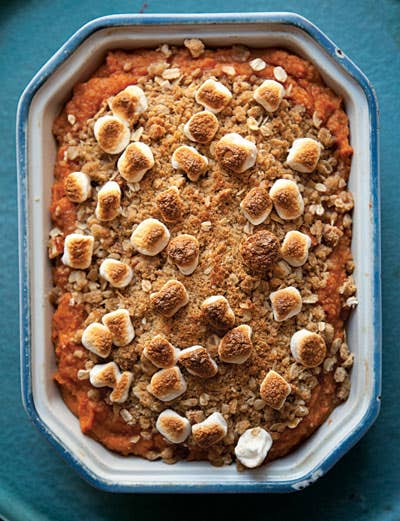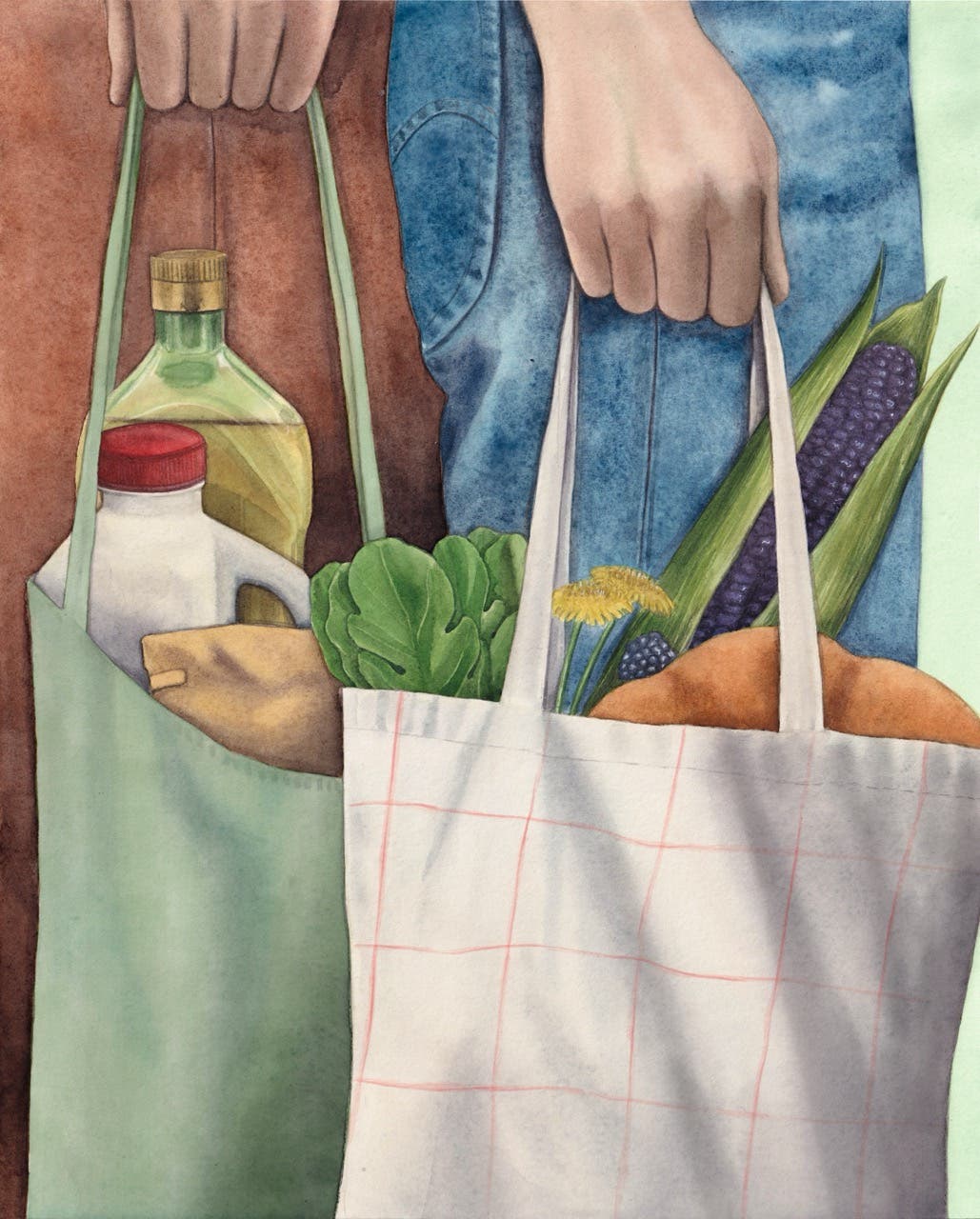
How Sweet It Is: The Perfect Sweet Potato Casserole
This casserole is a Thanksgiving tradition worth upholding
Truth be told, I used to shudder at the sight of the sweet potato casserole that appeared on our table each Thanksgiving. It was made with canned "candied yams," which were mushy and syrupy-sweet (sorry, Mom), and blanketed in an airtight layer of mini marshmallows. No one much cared for it. But in our Italian immigrant family, where we started the Thanksgiving meal with homemade pastina-and-cardoon soup, that casserole somehow seemed like a dish that had to be there, as if to prove that we were doing the holiday right.
In the '90s, when we started buying sweet potatoes raw and roasting them, the vegetable's pure, earthy flavor came as a revelation, and dressed-down sweet potatoes, simply roasted, supplanted that sticky-sweet casserole in our Thanksgiving program. But I love sweet potatoes; I love marshmallows. Couldn't the two work well together somehow? I figured a little research might help me find a way.
I learned that long before they donned their marshmallow hat, sweet potatoes were a fixture in the American diet. Early colonists found native people burying the tubers in the embers of fires and then peeling away the skin to eat the smoky flesh. Throughout the colonial era sweet potatoes were a staple in the South, but they remained a rarity up North until well into the 19th century. Sometimes the sweeter varieties were referred to as "yams," though it was acknowledged even then that a yam is actually a different root, native to Africa and Asia. African slaves, recognizing the sweet potato as the closest thing on these shores to the yams they knew, called them by the same name and embraced them in their cooking, further expanding the American sweet potato repertoire.
As sweet potatoes caught on in the North, they quickly became associated with Thanksgiving: An 1887 issue of Godey's Lady's Book, published out of Philadelphia, lists among its Thanksgiving "receipts" a sweet potato pie to be served either during the main part of the meal or as a dessert. And when the first edition of the Boston Cooking School Cookbook was published in 1896, it contained a recipe for another dish that was gaining in popularity: glazed or candied sweet potatoes, served as a side dish.
Then, a couple of decades later, sweet potato cookery got even sweeter. During the intervening years, mass production made marshmallows, formerly a penny candy painstakingly produced by hand, more widely available. In 1917, the marketers of Angelus Marshmallows hired Janet McKenzie Hill, founder of the Boston Cooking School Magazine, to develop recipes for a booklet designed to encourage home cooks to embrace the candy as an everyday ingredient. It featured plenty of instant classics, including fudge studded with chewy marshmallows; cups of hot cocoa dotted with them; and, yes, the first documented appearance of mashed sweet potatoes baked with a marshmallow topping.
Right away, Americans divided on whether that was a good thing. Southerners appeared to respect sweet potatoes too much to pair them with candy. "Most of the receipts direct you to…embellish with marsh-mallows," wrote Harriet Ross Colquitt in a recipe for candied sweet potatoes in The Savannah Cook Book (J.J. Little and Ives, 1933), but she made it clear that she considered her unembellished dish "far, far nicer." Northerners, by contrast, embraced marshmallows as the latest innovation. In a 1929 issue of Ladies' Home Journal, Caroline B. King, a native of Chicago, raves about a version she tried in Virginia, yet she can't help but interject her presumably more cosmopolitan ideas. Describing the twice-baked sweet potatoes loaded with butter, cream, paprika, and chopped pecans, she muses, "I find that a topping of halved or quartered marshmallows… improves even this luscious dish."
The 1930s marked the apex of the combination, celebrated in a recipe booklet from the marshmallow company now called Angelus-Campfire, titled "How Famous Chefs Use Campfire Marshmallows." It features dozens of marshmallow-laden dishes, including six different sweet potato ideas, as well as then-trendy combinations like cottage cheese with marsh-mallows and marshmallows and fruit chunks skewered on toothpicks. One wonders if it was keeping company with these sorts of dishes that made the marshmallow-topped sweet potato casserole seem so dated a few decades later.
Still, it would be a shame for this dish to fall by the wayside as a casualty of culinary snobbery. I decided to treat my sweet potato casserole with the same thoughtfulness I apply to the rest of the Thanksgiving meal. I seasoned it carefully, tasting as I went, sometimes heightening the sweetness with maple syrup or brown sugar or providing balance with roasted pecans or chunks of salty bacon. The addition of eggs, I found, makes for a nice, custardy texture.
In the past, I'd made the mistake of treating the tubers like regular potatoes: skinning and boiling them before mashing. But when it comes to sweet potatoes, this method produces a waterlogged, mushy texture, and it dilutes the flavor, too. I learned from several old recipes the trick of boiling them in their skins, after which the flesh slides easily from the peels. Still, boiling the potatoes whole means the narrower ends and the centers cook unevenly.
Roasting the sweet potatoes in their skins eliminates that problem and has the added benefit of intensifying their sweetness. Many Southern recipes recommend rubbing the skins first with butter or bacon fat, which certainly adds richness and flavor, but simply scrubbing the skins clean and pricking them all over produces excellent results: Ninety minutes at 425 degrees yields tender, sweet flesh that slips right out of the skin (though you might find that very large potatoes need a little bit more time). Many recipes recommend a potato masher, but sweet potatoes have a fibrous texture that clumps and shreds if mashed by hand. A ricer or food mill makes for the best, smoothest casserole.
The sweet potato casserole I now make synthesizes elements from various stages in the dish's evolution. Taking a cue from Southern cooks who top their casserole with pecans, I top mine with a pecan crumble made with oats, flour, butter, brown sugar, and salt, which provides the right sweet-savory crunch. That would be delicious enough, but to me it's just not complete without marshmallows: They're such a nice, airy counterpoint to the rich and earthy potatoes. I use them sparingly, as they were in the original recipe from 1917, which allows a large surface area of each marshmallow to crisp in the oven. It may not be how Mom used to make it, but it's a dish I truly love—and not just out of nostalgia.
Keep Reading
Continue to Next Story










